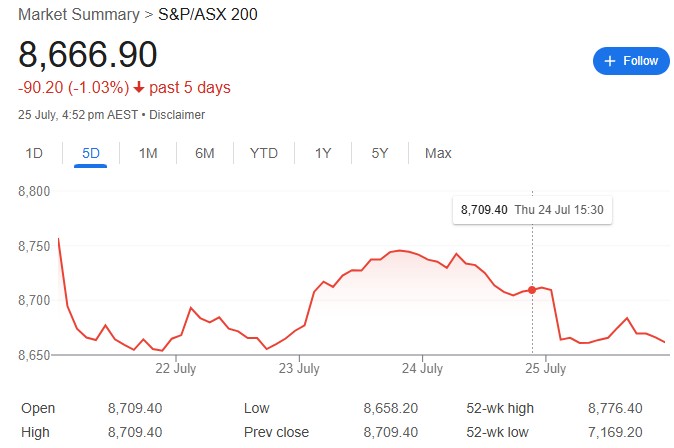| Name | Daily Close | Daily Change | Daily Change (%) |
|---|---|---|---|
| Dow | 44,693.91 | -316.38 | -0.70% |
| S&P 500 | 6,363.35 | 4.44 | 0.07% |
| Nasdaq | 21,057.96 | 37.94 | 0.18% |
| VIX | 15.17 | -0.22 | -1.43% |
| Gold | 3,342.80 | -30.7 | -0.91% |
| Oil | 66.3 | 0.27 | 0.41% |
OVERVIEW OF THE US MARKET
The S&P 500 and the NASDAQ pushed their record levels higher for the fourth week out of the past five as those two indexes and the Dow on Friday closed more than 1% higher for the week. Since June 20, the S&P 500 has risen more than 7% while the NASDAQ has added almost 9%.
The Dow on Wednesday briefly climbed above the index’s record closing high, but it couldn’t sustain that level and ended the trading day 4 points below its historic peak. While the S&P 500 and the NASDAQ have continued to push their records higher in recent weeks, the Dow’s closing level on Friday was 0.2% below the index’s record closing level of 45,014 set on December 4, 2024.
Approaching the busiest stretch of earnings season, seven mega-cap stocks are again expected to generate an unusually big share of overall second-quarter earnings growth. In aggregate, the so-called Magnificent 7 stocks were forecast to report average growth of 14.1%, according to FactSet. Excluding those big tech firms, the S&P 500’s other 493 stocks were expected to post much slower growth of 3.4%.
A market gauge that tracks investors’ expectations of short-term U.S. stock volatility fell 9% for the week, extending a recent decline that’s pushed the index to the lowest level in five months. The Cboe Volatility Index on Friday closed at 14.9, down from a recent high of 21.6 on June 17.
Ahead of an August 1 deadline set by the Trump administration, investors continued to closely track U.S. tariff negotiations with key trading partners. The administration announced progress toward deals with countries such as Japan and Indonesia, while negotiations continued with other partners such as the European Union, India, and Canada.
OVERVIEW OF THE AUSTRALIAN MARKET

The S&P/ASX 200 finished lower despite gains in energy, as weakness in materials and financials dragged sentiment.
The broad index fell 0.49% to 8,666.9, capping a week down 1.0%. The All Ordinaries dropped 45.1 points, or 0.50%, to 8,934.3, while the Small Ords slid 0.68% to 3,355.5. The Australian dollar weakened 0.14% to 0.6581, pressured by softer iron ore prices, though US futures rose, with the S&P 500 up 0.19% to 6,413.75.
Investors digested corporate updates on Friday, with some reflecting tariff concerns ahead of the August 1 deadline. Materials led declines, with Fortescue down 3.4%, BHP 1.9%, and Rio Tinto 0.8% as Singapore iron ore futures slipped, easing month-to-date gains to 8.0%. Energy surged 1.80%, with Woodside Energy up 3.7% after a strong June quarter report and robust FY26 guidance.
Financials fell 0.45%, with the Big Four Banks dropping 0.3% to 0.8%, nearing June 3 lows amid banking sector weakness. Gold miners retreated, led by Pantoro (-5.1%), Bellevue Gold (-4.4%), and Genesis Minerals (-4.1%), as gold prices dipped to $US3,356 an ounce, though Newmont rose 3.8% on better-than-expected Q2 earnings. Defence stocks like Droneshield tumbled 10%, while lithium names were mixed despite a 37% monthly surge in Chinese futures.

